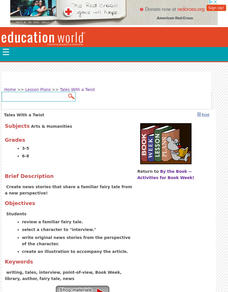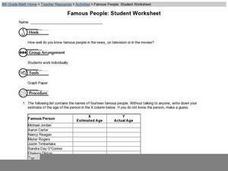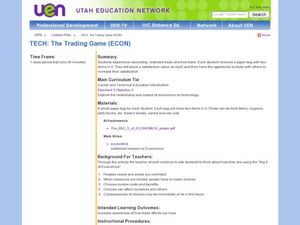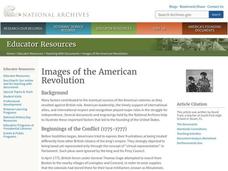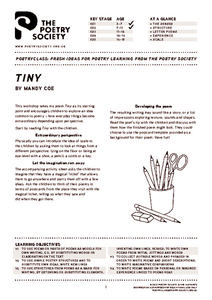Curated OER
Writing About Talking
The story of King Arthur is a fascinating one, and this retold excerpt offers an excellent example of narrative word choice in a dialogue. Learners read the text and examine the way the author uses synonyms for said. They write down all...
Curated OER
Taxi!
Your young taxi drivers evaluate and articulate the reasoning behind statements in a conceptual task involving linear data. The given data table of distances traveled and the resulting fare in dollars is used by learners to explore...
K5 Learning
Rhyming Animals
Second graders read an informational text passage on animals, as well as a poem that incorporates rhyming words. Then, 2nd graders answer questions based on what they read.
Curated OER
Past Continuous vs. Simple Past
What were you doing a minute ago? What about last year? Learners read a set of 10 sentences and fill in each blank with a simple past or past continuous verb listed in parentheses.
Poetry4kids
How to Write a Funny Epitaph Poem
What can happen if you eat too much cafeteria food? Or wear dirty clothes every day? Or talk back to your mother? Use a lesson on humorous poems as a way for students to practice silly rhymes as fictional epitaphs.
Education World
Thinking About Thanksgiving: Lessons Across the Curriculum
Bring two integrated curriculum resources about Thanksgiving to an elementary social studies unit. The first activity focuses on Squanto's contributions to the early Pilgrims' survival with a gardening activity in which learners add fish...
Virginia Department of Education
Linear Curve of Best Fit
Is foot length to forearm length a linear association? The class collects data of fellow scholars' foot length and the length of their forearms. They plot the data and find a line of best fit. Using that line, they make predictions of...
Curated OER
Tales with a Twist
Your authors create news stories that share a familiar fairy tale from a new perspective. They review a familiar fairy tale, select a character to "interview," and write original news stories from the perspective of that character.
Beacon Learning Center
Cartesian Classroom
Elementary schoolers become points on a Cartesian Plane in their classroom. They review ordered pairs, positive and negative coordinates, quadrants, and the x and y axes. Pupils follow commands that help review vocabulary, such as...
Curated OER
The Food Pyramid
Learning about nutrition and how to eat healthy foods is very important for kids these days. Here is a lesson plan, designed for 4th graders, that teaches these important skills. Pupils plan nutritional meals by using the USDA's Food...
Curated OER
Famous People: Student Worksheet
Older learners consider a list of famous people, and they fill in two columns; one in which they guess the celebrities' ages, and another where they look up their actual age. They construct a graph by assigning one of the columns the x...
Curated OER
Grouping Buttons
Looking for a good lesson on counting and sorting? This lesson is worth a look! In this classification lesson, learners sort buttons by color, shape, shiny verses not shiny, or number of holes.
Curated OER
Verbal Moodswings
Finally, a handout that accurately describes the difference between indicative, imperative, and subjunctive verb tenses! Complete with sentences, examples, and even some humor. Never be confused again!
Primary Resources
Coordinate Pairs: An Introduction
Ordered pairs, the x and y-axis - sounds like it's time to introduce learners to the plotting points on a graph! This presentation is great as it introduces the concept, provides an example of how to use a coordinate plane, and then...
Curated OER
TECH: The Trading Game
Property ownership, restricted trade, and free trade are the topics of this game. Kids play a trade game to better understand the interrelationship between technology, economics, and personal choices. Rules to the game and a series of...
Brigham Young University
The Giver: Magic Squares
Combine math and vocabulary in a fun activity based on Lois Lowry's The Giver. Before kids begin the book, they look up the definitions of 16 vocabulary words and complete a puzzle that will give them the same number.
Curated OER
Reading Comprehension 1
Bring this non-fiction text into your eleventh and twelfth grade classrooms. Your high schoolers will read the long passage provided, and use the information to complete eight multiple-choice questions. The answer sheet details where one...
Curated OER
Reading Comprehension - Short Stories
Much more than a simple reading assessment, this resource can form the basis of a review of comprehension strategies, as a worksheet that models for readers how to employ strategies to answer questions based on passages, or as a practice...
Curated OER
Dulce et Decorum est by Wilfred Owen
It is entirely fitting and proper that Wilfred Owen’s powerful “Dulce et Decorum Est” is the poem used for an exercise in close reading, discussion, analysis, and argumentative writing. Class members discuss focus questions in pairs,...
Illustrative Mathematics
Peaches and Plums
According to the resource graph, which costs more: peaches or plums? Algebra learners compare two proportional relationships and then throw in a banana. Leaving out the scale helps students become intuitive about graphing.
Resources for Educators
Math & Science Connection
Whether you're using a collection of Dr. Seuss books to teach basic math skills like counting, adding, and subtracting, or exploring the different states of matter by melting a crayon with a hairdryer, a series of 11 fun activities...
Poetry Society
Tiny by Mandy Coe
Introduce magic and imagination into your classroom with a poetry activity. Learners read the poem "Tiny" by Mandy Coe and use their magic tickets to visit any place they can think of! The final result is a poem describing where they...
EngageNY
How Do 3D Printers Work?
If we stack up all the cross sections of a figure, does it create the figure? Pupils make the connection between the complete set of cross sections and the solid. They then view videos in order to see how 3D printers use Cavalerie's...
It's About Time
Making Waves
Young scientists use Slinkys to better understand waves. After creating and measuring many aspects of waves, they complete a handout and homework questions. The resource also introduces the final project for the chapter, though it does...









